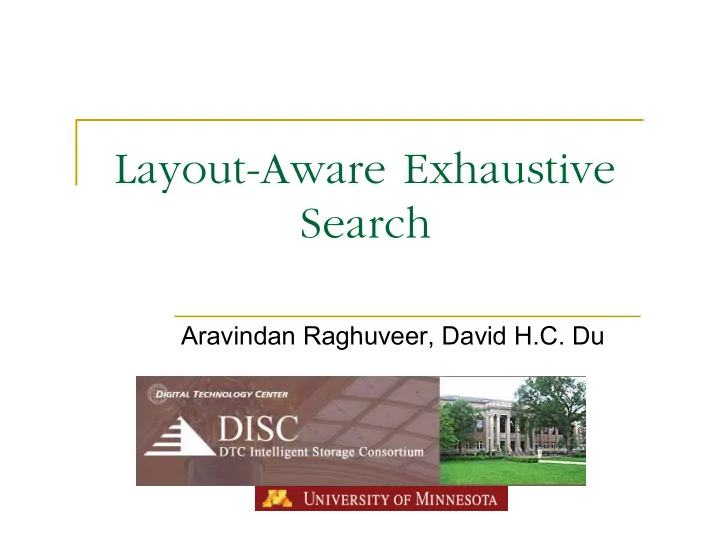

Layout-Aware Exhaustive Search Aravindan Raghuveer, David H.C. Du
Introduction Exhaustive Search Examine all objects in a storage system. Expensive Operation Why Exhaustive Search ? Fuzzy Queries: Semantic gap in image, video hard to annotate Content-based (Query-by-Example) Demonstrated in the Diamond project at Intel/CMU Index Creation: Not effective: Curse of dimensionality Too expensive Not always possible: Fuzzy queries A “necessary evil” feature on all filesystems. 2/20/07 FAST’07 WiP
Technology Trends and Exhaustive Search Bits per unit area increasing rapidly I/O Bandwidth lagging behind Effect on exhaustive search: 1 day to sequentially read 10TB* 5 months with 8KB chunk random access !! Filesystem level exhaustive search: Recursive exploration of directories. With aged, fragmented filesystems: At the disk: an Exhaustive search will look more like random access than sequential. * Dr. Jim Gray’s keynote from FAST’05: 2/20/07 FAST’07 WiP
Filesystem Applications and Exhaustive Search Exhaustive Search : Long running, I/O intensive task. Other filesystem applications running concurrently. Concurrent execution of both: Performance Isolation: Impact on response time of other applications should be minimal. Impact on efficiency of exhaustive search should be as low as possible. 2/20/07 FAST’07 WiP
What this work is about ? A fresh look at Exhaustive Search As a first class service provided by the storage system. Close-to-sequential performance always Concurrent execution with other filesystem apps. Without compromising extensively on response time and efficiency 2/20/07 FAST’07 WiP
An Overview of proposed approach Layout aware: Search order not based on logical filesystem view but physical on-disk organization. As close to sequential performance as possible. Suspend-and-resume On a real-time request to disk: Suspend exhaustive search. Service real-time request. Resume exhaustive search. Modify search order based on current disk head position. 2/20/07 FAST’07 WiP
Ingredients in the Solution Architecture: Where to embed functionality: filesystem or smart object based disk ? Layout-Aware Search: Planning the search ? Metadata handling and placement? Where are object extents located List of objects already scanned Suspend-Resume: Maintaining search progress metadata to avoid re-scanning [suspend] Computing new search plan [resume] 2/20/07 FAST’07 WiP
Current Status Layout-Awareness: 2 modes of layout-aware search. Pre-planned and adhoc. Pre-planned used when the disk stores a small number of objects. Adhoc mode used when the disk is almost full. Pre-planned and adhoc can be used at finer granularities (example: different modes on different areas of the disk) Suspend-Resume: Suspend: Search Metadata is distributed over the disk, close to the data. Resume: Based on the remaining number of objects we either shift to the pre-planned or adhoc mode. 2/20/07 FAST’07 WiP
Recommend
More recommend